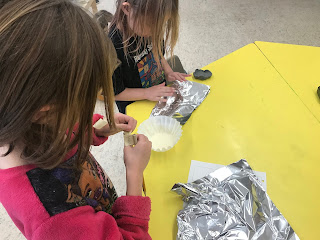This week we . . .
"We did an experiment with water. We had things that were made out of paper. We made a prediction and then next we used eye droppers dipped in water and we did a test to see if the paper absorbed the water." - RG
"Some of the materials we used for the science experiment were coffee filters, cardboard, wrapping paper, napkins, paper plate, wax paper, tin foil, and paper towel." - SW
"Me and K.N. at recess built this cool house with snow." - WB
"In math (the grade 2s and a couple grade 1s) have been doing geometry. We were working on sorting shapes. We we were sorting them by curved and straight lines." - KR
"We talked about responsibilities like cleaning up, doing your work, going to school, and walk the dog." - NS
"A responsibility is a job you do." - MW
Over the last few weeks, students have been working on firming up their benchmarks of 5 and 10 in math (1+4 =5, 2+3=5, 5+0=5 . . . and 1+9=10, 2+8=10, et.). Developing an understanding of these number relationships are very important as kids start to compute with numbers and develop efficient strategies. This skill can be easily supported at home in your everyday activities. Next time your shopping, ask questions like, "I have seven oranges, how many more do I need to get to ten?".
Grade 1 students have also been working on counting forwards and backwards within 20. Counting backwards is a critical skill that children often find difficult.
Grade 2 students have been working on ordinal numbers (1st, 2nd, etc.) and counting on when solving addition equations within 20.
In writing we have been working on developing a concept setting. The place and/or time when a story takes place. Students have been asked to imagine themselves in their stories as they build it. What can they see (colors, animals, plants, objects, etc.)? What can they hear? What strikes you as unusual about this place? We will be using our visualizations to help us add juicier, more descriptive explanations of setting in our writing.
In addition to developing our recognition of RED words (words that can't be sounded out) we have also been working on retelling stories by talking about the beginning, middle, and end.









